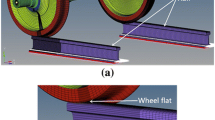Abstract
In this investigation, a numerical procedure for wheel/rail one and two-point contact geometry analysis is developed for predicting the location of contact points in curved negotiations on a tight radius curved track. The proposed method accounts for the change in the longitudinal location of contact point along the curved track as well as the circumferential contact point on the wheel flange. For the purpose of validation, simulation results for one and two-point contact scenarios are compared with those obtained using the experiment. The experiment is performed on a test track of R48 curve using an actual truck, and the location of contact points for given lateral and yaw displacements are measured on the tight radius curved track. It is demonstrated that good agreements are obtained between the simulation and experimental results in tread and flange contacts.
Similar content being viewed by others
References
Shabana, A.A., Zaazaa, K.E., Sugiyama, H.: Railroad Vehicle Dynamics: Computational Approach. CRC Press, Boca Raton (2007)
Marquis, B., Pascal, J.P.: Report on a railway benchmark simulating a single wheelset without friction impacting a rigid track. Veh. Syst. Dyn. 46, 93–116 (2008)
Pombo, J., Ambrosio, J.: Application of a wheel-rail contact model to railway dynamics in small radius curved tracks. Multibody Syst. Dyn. 19, 91–114 (2008)
Malvezzi, M., Meli, E., Falomiand, S., Rindi, A.: Determination of wheel-rail contact points with semi-analytic methods. Multibody Syst. Dyn. 20, 327–358 (2008)
Shabana, A.A., Zaazaa, E.K., Escalona, L.J., Sany, J.R.: Development of elastic force model for wheel/rail contact problems. J. Sound Vib. 269, 295–325 (2004)
Cooperrider, N.K., Law, E.H., Hull, R., Kadala, P.S., Tuten, P.S.: Analytical and experimental determination of nonlinear wheel/rail geometric constraints. Report No. FRA-OR&D 76-244 (PB-252 290) (1975)
Kortüm, W., Sharp, R.S.: Multibody Computer Codes in Vehicle System Dynamics. Swets & Zeitlinger (1993)
Sugiyama, H., Suda, Y.: On the contact search algorithms for wheel/rail contact problems. ASME J. Comput. Nonlinear Dyn. 4, 041001-1-7 (2009)
Sugiyama, H., Suda, Y.: Wheel/rail two-point contact geometry with back-of-flange contact. ASME J. Comput. Nonlinear Dyn. 4, 011010-1-6 (2009)
Rabinowitz, P.: Numerical Methods for Nonlinear Algebraic Equations. Routledge, London (1970)
Escalona, J.L., Gonzalez, M., Zaazaa, K.E., Shabana, A.A.: A study to validate multibody wheel/rail contact algorithms. Technical Report MBS02-8, University of Illinois at Chicago, Chicago, IL (2002)
Sugiyama, H., Matsumura, R., Suda, Y., Ezaki, H.: Dynamics of independently rotating wheel system in the analysis of multibody railroad vehicles. ASME J. Comput. Nonlinear Dyn. (in press)
Author information
Authors and Affiliations
Corresponding author
Rights and permissions
About this article
Cite this article
Sugiyama, H., Tanii, Y., Suda, Y. et al. Wheel/rail contact geometry on tight radius curved track: simulation and experimental validation. Multibody Syst Dyn 25, 117–130 (2011). https://doi.org/10.1007/s11044-010-9215-x
Received:
Accepted:
Published:
Issue Date:
DOI: https://doi.org/10.1007/s11044-010-9215-x




